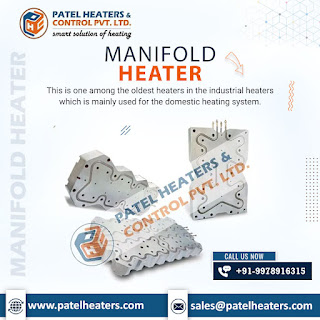Choosing the Right Manifold Heater for Your Application
The efficient and accurate heating of fluids or gases inside a manifold system is essential in a wide variety of industrial operations, and this is where Manifold Heater come in. Choosing the best heater for a certain application is crucial for maximising efficiency, productivity, and dependability.
 |
| Manifold Heater |
The purpose of this article is to serve as a thorough resource for determining which heater will best serve your needs. Engineers and technicians may optimise the performance of their complex heating systems by examining variables such as heater type, material, watt density, temperature range, and ambient circumstances.
Recognising the Need for Manifold Heating
The chemical processing, oil and gas, food and beverage, pharmaceutical, and other sectors are just some of the many that use manifold heater. For procedures like heating, drying, curing, or preserving viscosity, they are used to heat fluids or gases inside a manifold system with pinpoint accuracy. To choose the proper heater, you must have a thorough understanding of your application's needs.
Manifold Heater Varieties
They come in a variety of styles, each with its own set of advantages and disadvantages. Some typical examples are:
a) Electric Strip Heaters: These heaters have a stainless steel sheath around a resistive heating element. They are useful for heating large surface areas inside a manifold and are intended to give consistent heat over the length of the heater.
b) Tubular heaters: Tubular heaters are adaptable and may be shaped to meet a wide variety of manifold designs. They may be tailored to meet individual heating needs while still providing effective heat transmission.
c) Ceramic infrared heaters: These heaters produce infrared radiation that may be directed to a specific area. They're well-known for the quick heat transmission and precise heating they provide.
Factors to Think About When Buying Heater
Several considerations must be made in order to choose the most appropriate manifold heater for your needs.
a) Temperature Range of Operation
Find out the temperature range that will work for your needs. It is essential to choose a heater that can function within the required temperature range, since different models have different maximum and minimum temperatures.
b) Adaptability to Liquids and Gases
Take into account whether or not the fluid or gas you're trying to heat is chemically compatible with the heater materials. Materials that can survive the corrosive or reactive properties of Laboratory Oven are necessary.
c) Watt density
Watt density is the ratio of the heater's power output to its physical footprint. Picking a heater with the right amount of wattage is crucial. Heaters with a lower watt density provide a more uniform heat field, while those with a higher watt density are better for spot heating.
d) Heater Sizing and Setup
Think about the dimensions of the manifold and the room you have to work with. Pick a heater that fits your system's requirements and gives you the heating coverage you need.
e) The State of the Environment
Think about the setting where the heater will be used. Materials and safeguards for the heater should be chosen with environmental factors such humidity, moisture, dust, and corrosive atmospheres in mind.
Advice and Personalization
Manifold heating applications often have specific needs, so it's a good idea to talk to the people who make or sell the equipment. They have the knowledge and experience to provide advice and suggestions. Heaters by Manifold Heater manufacturers in India may be made to order in a wide variety of forms, watt densities, and materials to suit a wide variety of applications.
● Assessing Manufacturers and Suppliers
Think about the heater vendor's track record, dependability, and experience before making a purchase. Try to find businesses who have a history of providing reliable heating solutions and outstanding customer service. Check into things like guarantees, tech support, and access to replacement components.
● Setup, Functioning, and Upkeep
Once you've decided on the right heater, follow the manufacturer's instructions for proper installation. To avoid any dangers, make sure all electrical connections are properly insulated and made.
To preserve the heater's lifetime and dependability, its performance should be monitored often and regular maintenance should be performed. Maintenance should be performed in accordance with the manufacturer's guidelines, and periodic inspections should be performed by a trained technician.
Conclusion
If you want fast, accurate, and dependable heating, you need to get the proper heater for the job. Engineers and technicians may make smart choices by thinking through variables including heater type, material, watt density, temperature range, environment, and other needs. When used in a variety of industrial processes, manifold heating systems thrive when their components are carefully chosen, installed, operated, and maintained for maximum performance, energy efficiency, and longevity.
Patel Heaters & Control Pvt Ltd is Manifold Heater suppliers in India committed to exceptional standards of quality, performance and longevity as far as its products are concerned.


Comments
Post a Comment